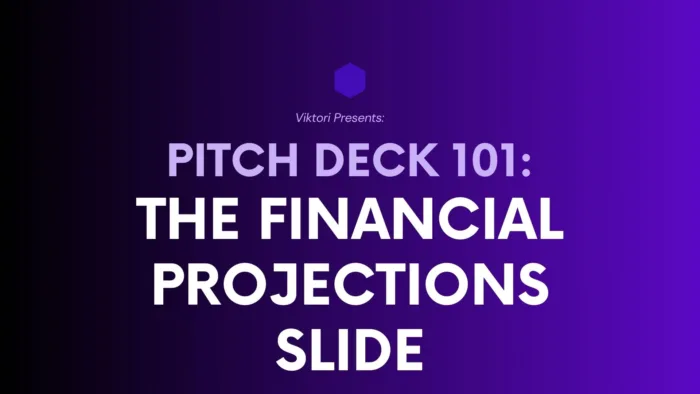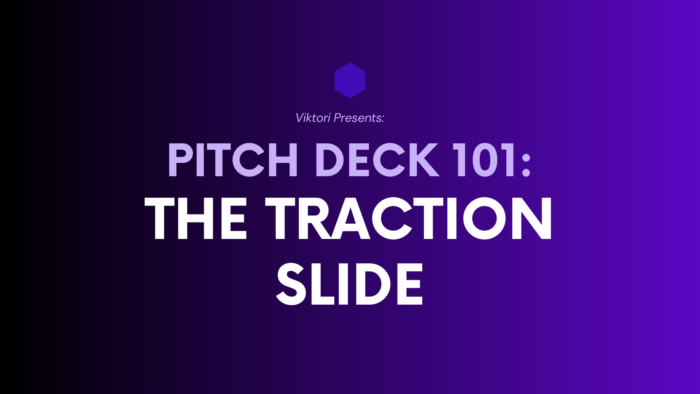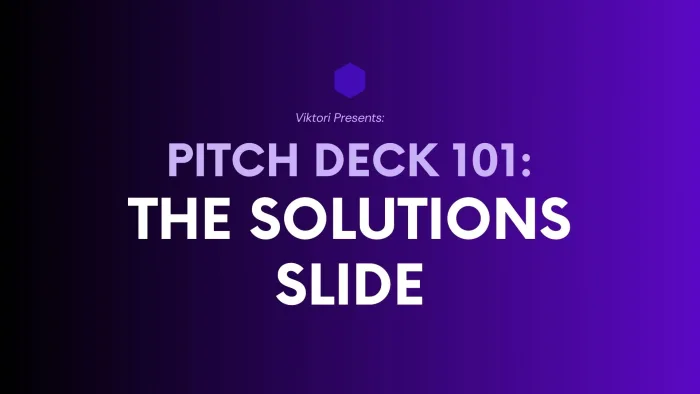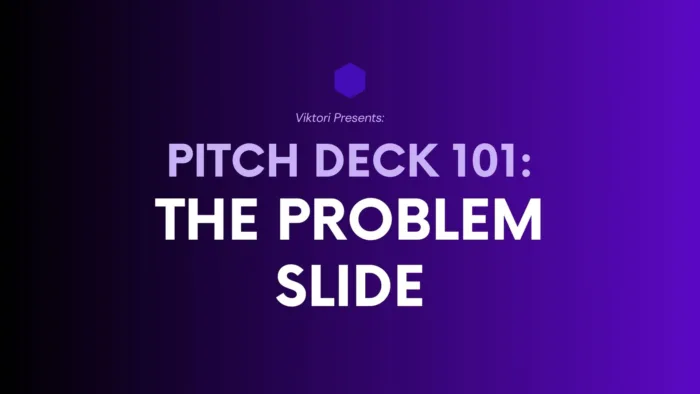If you want to present a new product or service to the market or help your organization understand how marketing campaigns positively impact product sales, you definitely need a marketing deck.
I’m Viktor, a pitch deck expert and creative business strategist. Over the past 13 years, I’ve helped businesses secure millions of $ in funding thanks to my approach and I’m sharing it here in this pitch deck guide.
I’ve been part of small and big marketing teams, and I know why these decks work and don’t work.
This guide specifically aims at helping you understand what a marketing pitch deck is and how you can create one.
Let’s dive in.
Get an investor ready pitch deck that gets you funded and saves over 30 hours of your time.
Join 100s of successful entrepreneurs who’ve transformed their pitch decks by using my hands-off approach, which includes: market research, copy, design, financials, narrative and strategy.
1 week turnaround time and less. Special pricing for early stage companies.
The least you will get on this call is 10 actionable tips & strategies to own that next pitch, worth $599, for free.
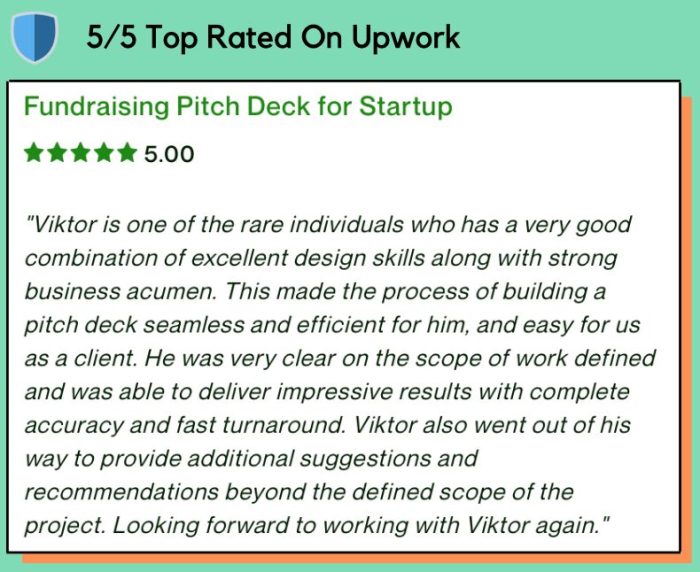
What Is a Marketing Deck?
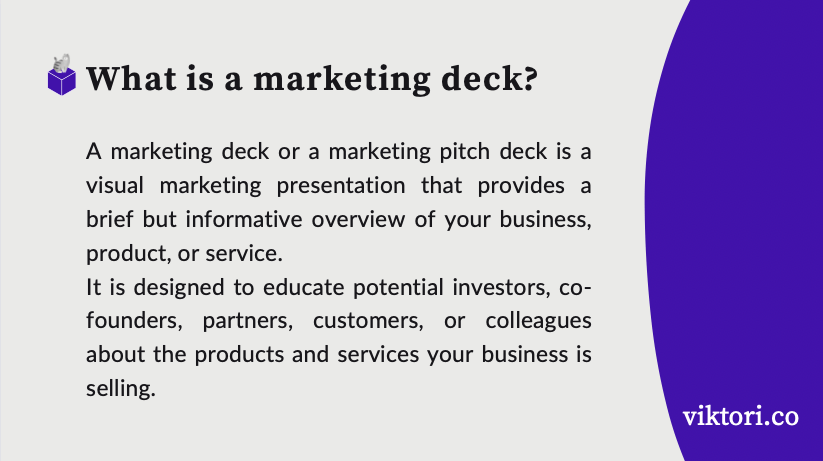
A marketing deck or a marketing pitch deck is a visual marketing presentation that provides a brief but informative overview of your business, product, or service.
It is designed to educate potential investors, co-founders, partners, customers, or colleagues about the products and services your business is selling.
Ideally, it should cover the key points of your business plan, the purpose of the products and services you provide, high-level financial projections, and funding needs.
What is the Purpose of a Marketing Deck?
Capturing the target audience’s attention while marketing a brand or a business can be one of the most frustrating things to do.
Especially nowadays, when we are pretty busy and our attention spans are tremendously lowered, it can be a real challenge to present your product or service in the best light in a short amount of time.
That’s where the marketing deck enters the picture, with its primary intention – to make the acquaintance of the purpose and value of your product, service, or business idea to your target audience.
Introducing your audience to what you’re offering to the market this way should ideally make them able to recognize the need to support, purchase, or advocate for your brand after viewing it.
SMEs, medium to large organizations, and heck, even one-person agencies can use marketing decks as one of the main tools to get new clients and increase sales.
Why Is A Marketing Pitch Deck Important?
If you want to attract customers or partners or get your team to understand the value of the work they contribute to your organization and towards your goals, you will find that a marketing deck is especially helpful in achieving the following:
- Providing the necessary information for customers and stakeholders to help them make informed decisions.
- Allowing employees to understand your business based on the products and services you’re selling much better.
If your marketing deck is fine-tuned, structured, and made with a purpose, it’s one of the most important tools to help an organization grow, whether it’s by getting more funding or winning new clients.
Which Slides Should a Marketing Deck Include?
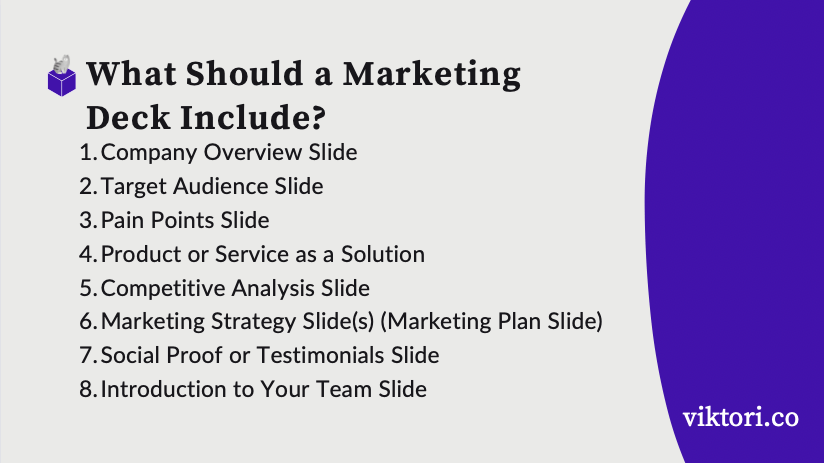
The best marketing decks are lean and contain 8 slides of crucial information that their target audience will understand and ultimately act upon.
To make one, you need to have more than an in-depth and thorough knowledge of your industry and the idea you are selling.
You need to know the particular problem that your idea is solving, your target market, the competition, rival products, anticipated revenues, and the uniqueness of your idea.
You need a total breakdown of your pitch, meaning you need to explain each part in as much detail as possible in the shortest amount of time available.
You also need to know your industry’s numbers, upsides, downsides, worst/best-case scenarios, and ins and outs. Most importantly, you must know how to weave in a story narrative worthy of a movie trilogy. To help you improve your narrative, check this selection on the best books for pitching. The authors have won billions in $ thanks to their ability to create stories when pitching and are sharing their methods with you.
If you plan to present in front of investors, your idea should create a feeling with your investor that their money is not just in safe hands but will at least quadruple within a certain period of time.
So, if attracting investors is your main goal, especially if you are just starting with your business, following the startup pitch deck guide on how to create a pitch deck for investors might be of great help to you.
Apart from that, the main components an effective marketing deck should include are:
1. Company Overview Slide
The company overview slide should introduce the company, product, or service in one or two sentences.
Stating your unique value proposition (UVP), also known as unique selling proposition (USP), in this slide is also an important part.
You want your audience to get to know who you are and what your business does without saying a lot. This can be achieved by answering the question, “Who are you, and why should people listen to you?”
Do not forget to include your logo, phone number, and email address in this slide. You want a simple yet solid pitch deck when reaching out to your audience.
This slide should answer the following questions:
- Will the audience know exactly what you offer and the problem you solve just by looking at this presentation?
- Is the slide content clear and to the point?
- Have I designed it well?
- Is the content short, stupid and simple?
- Would your audience decide then and there to accept your offer without even looking at the rest of the presentation?
Company Overview Slide Example
Here’s an example of a company overview slide for an e-commerce selling bedsheets:

2. Target Audience Slide
This is the second component and is supposed to include your audience’s statistics, market size, and opportunity for your business to succeed in the space.
You can also highlight market validation or the reason why someone needs your product or service.
Also, breaking down your buyer’s persona (research-based representation of your ideal customer who will be the most interested in your products or service) using demographics and psychographics that align with your target market would be very useful.
This slide should answer the following questions:
- Who are you servicing?
- How big is the market?
- Is there a clear opportunity?
- Is there a clear danger?
- Is there a defined market?
Example Target Market Slide
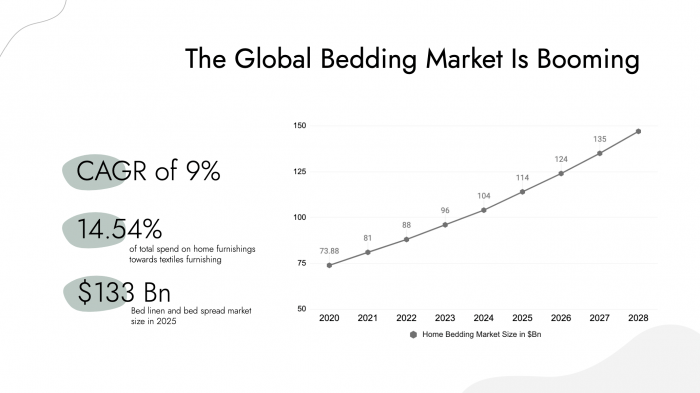
3. Pain Points Slide
The pain point slide discusses the problem your product or service will address. In this slide, you’re touching on your audience’s wound that needs healing.
Implementing storytelling tactics by using real-life people undergoing the same issues is proven extremely beneficial for this slide:
It is very important to show your audience that you are solving a real problem or pain point since you don’t want them to lose interest in your presentation.
Therefore, this slide should answer the following questions:
- What is it that you are addressing?
- Who are the people experiencing this problem?
- What is the problem’s impact on the people experiencing it?
- How does the person address the problem right now, and how are these solutions helping them?
My Tip: Use visuals to explain more complex issues. Illustrating how serious the problem is through data could also be very helpful for them to understand your solution’s usefulness better.
This slide is where you show your audience that you truly understand what pains them.
Pain Points Slide Example
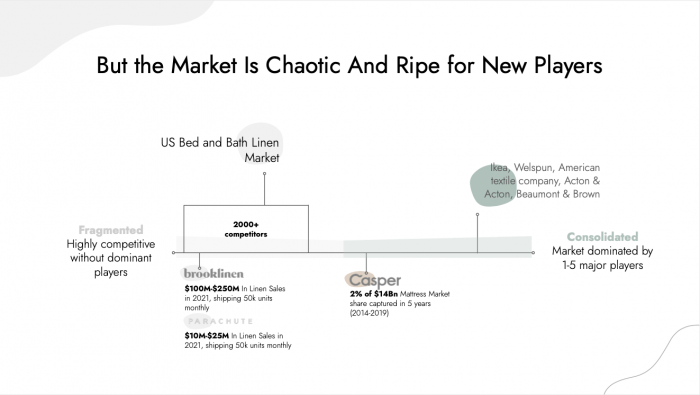
4. Product or Service as a Solution Slide
After sharing the problem(s) you’re solving, your next step is to present the products/services that your business is offering as a solution. It is good to mention your unique value proposition and how it ties back to your product.
You will absolutely find it advantageous to support it with relatable stories and visuals like video clips, photographs, or even a physical demo of your product.
Therefore, this slide should answer the following questions:
- Is it clear what my solution does?
- Is it clear what the benefits are?
- Is it clear how my solution helps?
- Have I used visuals and illustrations to explain my solution?
Don’t describe your solution in detail. Providing a higher-level overview of your solution and letting the visuals speak for you instead will grant you the optimum outcome.
Product Slide Example

5. Competitive Analysis Slide
The competitive analysis slide is where you show your competitors how your product/solution stacks up against them.
The purpose of the comparison is to demonstrate what sets your product apart from other similar products on the market. The distinguishing factors should address the needs and concerns of your target audience, making them more likely to choose your product over others.
Therefore, this slide should answer the following questions:
- Who are the competitors?
- What do they have that we don’t?
- What do we have that they don’t?
- What’s our advantage?
- How do we stack against them?
Competitive Analysis Slide Example
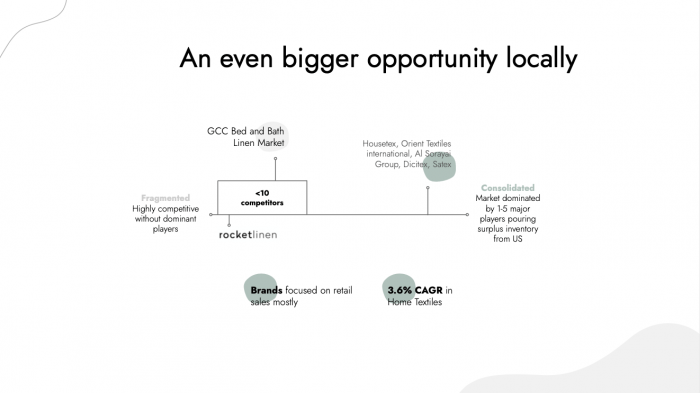
6. Marketing Strategy Slide(s) (Or Marketing Plan Slide)
The Marketing Strategy Slides will show the strategy you will implement to market to your audience.
Your marketing strategy should include a plan for how your campaign’s timing, tactics, pricing, and measured metrics can help you gain market share and improve sales.
So, you might find answering the below questions helpful in regard to this slide:
- How will you market to prospective customers?
- What kind of marketing assets are you planning to create?
- What methods and means will you use to reach your customers? Why do you think they will work? Provide any proof you have that this can be achieved.
- What’s your pricing like?
- What are your target conversion rates?
Marketing Strategy Slide Example
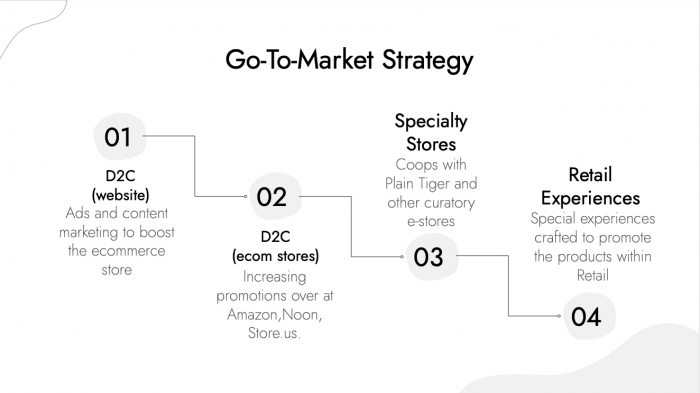
7. Social Proof or Testimonials Slide
One great way to inspire investors’ or customers’ confidence is to let them know that other people like them trust you since that can influence their decisions on whether to back or buy your product.
Use positive reviews and feedback from media publications, social media, and review sites to show that your product works and has helped people overcome their problems.
Questions to think about:
- Are the testimonials relatable?
- Is the feedback actionable and fact-packed?
Getting feedback from well-known brands, public figures, and influencers in your field would be even more convincing.
Testimonial Slide Example
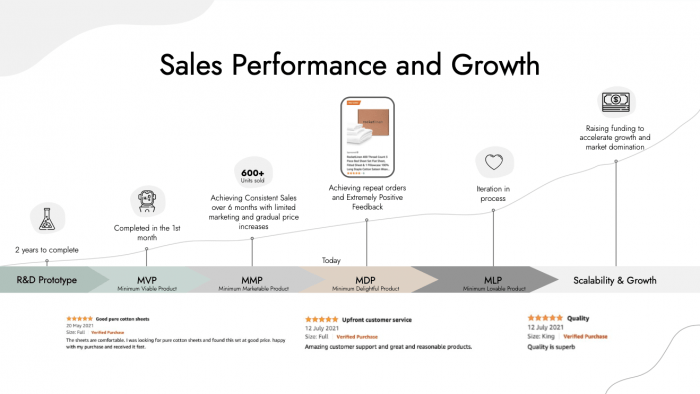
PRO TIP: Combine it with your sales and marketing or traction slide to increase the impact of your results and testimonials.
8. Introduction to Your Team Slide
People tend to pay attention to the faces launching the product as much as they do about the product itself.
So, ending the presentation by listing the amazing people behind your awesome organization will potentially attract them even more, whether they’re customers, investors or anything in between.
The purpose is to increase trust in your product and your team.
To do this, it would be best to mention things like their experience in the industry, milestones, achievements, and other factors that will help raise their profile.
Questions to think about:
- Have I highlighted the right information?
- Is the information easily read and organized?
- Does it reinforce the rest of the presentation?
You want to demonstrate to them that the individuals behind the product/service are competent, reliable, and trustworthy, just like what you are offering itself.
Team Slide Example
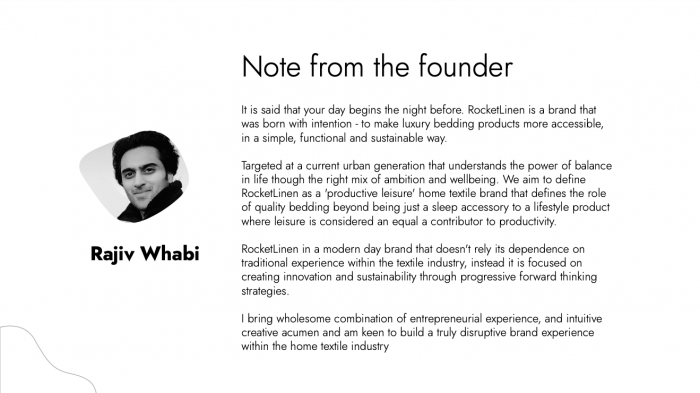
Marketing Pitch Deck Presentation Objectives
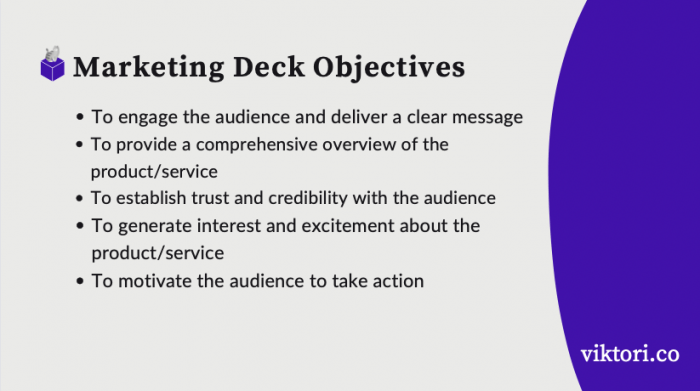
The way you present the information in the marketing deck is arguably just as important as the deck itself. So, how do you effectively present the information to the audience once the deck is prepared?
The following are key objectives for a successful marketing presentation:
- To engage the audience and deliver a clear message
- To provide a comprehensive overview of the product/service
- To establish trust and credibility with the audience
- To generate interest and excitement about the product/service
- To motivate the audience to take action
Setting Out the Goal
The purpose of any marketing presentation is to make it clear to the audience what the goal is from the outset. From the start, being unambiguous and honest about your objective is crucial.
Let them know why you are passionate about your company’s products/services. Create excitement about the topic and maintain an energetic tone throughout the presentation.
You want to keep your audience engaged from the start till the end.
Marketplace Overview
After identifying the goal for the presentation, providing a marketplace overview as an introduction to your plan is the next thing you want to present.
Make your products stand out from the competition. Show the audience why your product is the better choice and how it will positively impact them. Keep the focus on your product’s positive attributes rather than on what makes the competition’s offerings inferior.
Presenting a few interesting facts about your competitors or showing some statistics about customer demographics will help the audience get a clearer picture of the overall market.
7 Marketing Deck Tips and Tricks
The most important marketing presentation objective lies in presenting the information in an easy-to-understand and visually appealing way.
- Ensure to include enough information in your presentation to show that your plans and strategies are plausible and will work, but be careful not to give too much information.
- Try keeping it simple as much as possible, giving an accent to the most important parts.
- Use numbers and statistics to show how the customer will benefit from using your product/service. For example, if your product saves the customer time, express this in terms of how much time they will save.
- Remember that not all members of the audience are absorbing information in the same ways. Some people are visual learners, some auditory learners and others tactical learners. Some people learn best by seeing things, others by hearing things, and others by touching or doing things.
- There are several ways to make your marketing plans and strategies more appealing to different stakeholders. One way is to present them in a visually appealing format, such as through slides or illustrations. Another way to make them more appealing is to clearly and concisely explain the importance of the charts and graphs. Finally, you can bring in samples of the products and services you are presenting.
Hold on. You might want to check my list on the best presentation and communication books...
These are crucial books that will help you improve the design and structure of your decks and presentations, besides improving your delivery and skyrocketing your confidence when facing investors. Check them out below.
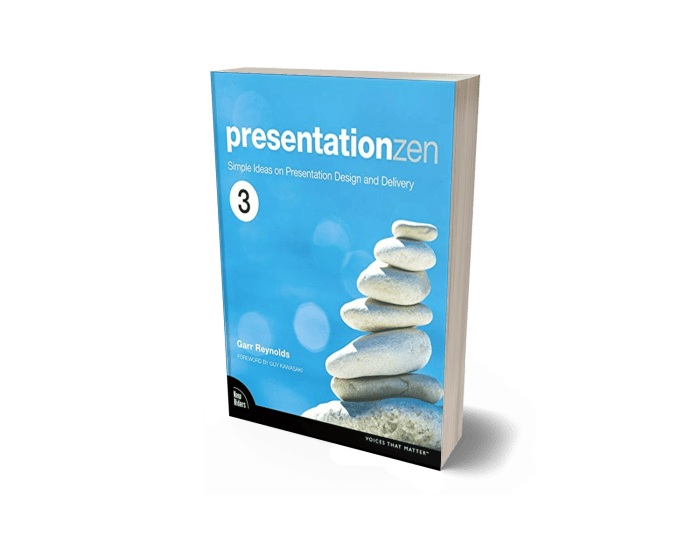
- Including the customer in the presentation by showing him how he exactly will benefit is also a great example of this. Show them the problem that you can solve for them or the need your products/services can satisfy.
- Be friendly, engage your audience and be open to feedback.
Marketing Deck Next Steps
The ideal marketing presentation should end with a discussion on the next steps and space for feedback from the audience. If you can, it would be great to provide a timeline for where the project is going from here.
Ending the presentation with a list of the next steps is a good way of getting your audience to share their thoughts and expectations based on what you’ve presented.
Ensure you allow plenty of time for the audience to ask questions during or after your presentation. Be open to listening and discussing everything they bring up. Your goal is to create an ongoing dialogue with the customer prospect.
You can even set up a time for a follow-up meeting or phone call if needed.
It would be great to offer to send or email additional product literature to address questions they may have expressed.
The Marketing Template You Can Steal And Use Right Now
The above is is just a simplified pitch deck version developed as part of our entrepreneurship program for graduate studies.
Founders that are serious about getting the funding they need, opt in for a deck has industry specific content, superb narrative and award winning design like these ones below:









I can help you build that deck with my hands-off process in 7 days or less.
Book a free 30 minute call below if you’re serious about getting an investor ready deck, and we’ll discuss your needs in detail. I’ll help you design the deck, write the content, develop the narrative and flesh out the strategy with financials.

We help 15,000+ founders every month create better pitch decks.
Alternatively, get the custom template for just $69,99.As soon as the payment is processed I’ll send over a quick questionnaire and deliver the deck in 24 hours and less.

Follow us on social for the newest templates:
Slide 1: Elevator Pitch
- Goal: Quickly grab the audience’s attention with a concise summary.
- Content:
- Headline: A powerful statement summarizing the core idea.
- Message: A one-sentence summary of your solution, target audience, and key benefits.
- Visuals: Use an impactful image or graphic to capture attention.
- Example: “Revolutionizing [Industry] with a Game-Changing Solution for [Target Audience].”
Slide 2: Investor Highlights
- Goal: Showcase the most compelling reasons to invest right away.
- Content:
- Headline: “Key Highlights”
- Message: Bullet points covering:
- Impressive growth metrics (e.g., revenue, user growth)
- Market size and opportunity
- Key partnerships or unique technology
- Visuals: Use icons or infographics to highlight data points.
Slide 3: Problem Statement
- Goal: Define the problem your solution addresses.
- Content:
- Headline: “The Challenge”
- Message: Agitate the problem—show what’s at stake if it’s not solved.
- Visuals: Charts or images that highlight the pain points.
- Example: “Businesses lose $X million annually due to inefficient marketing strategies.”
Slide 4: The Solution
- Goal: Clearly explain how your solution addresses the problem.
- Content:
- Headline: “Our Solution”
- Message: Describe how your solution fills the gap with a clear, concise explanation.
- Visuals: A diagram or infographic showcasing how it works.
- Example: “Our AI-powered platform optimizes ad spend by 30%.”
Slide 5: Market Opportunity
- Goal: Demonstrate the size and scalability of the market.
- Content:
- Headline: “A $X Billion Market Opportunity”
- Message: Show TAM (Total Addressable Market), SAM (Serviceable Available Market), and SOM (Serviceable Obtainable Market).
- Visuals: Market size graphs, segmentation charts.
Slide 6: Unique Value Proposition
- Goal: Highlight what sets your solution apart from competitors.
- Content:
- Headline: “Why We’re Unique”
- Message: Focus on the key differentiators and competitive advantages.
- Visuals: Comparative analysis with competitors.
- Example: “Unlike competitors, our solution reduces churn by X% through personalized analytics.”
Slide 7: Customer Success Stories
- Goal: Build credibility by showcasing real results.
- Content:
- Headline: “Proven Results”
- Message: Highlight case studies or testimonials.
- Visuals: Before-and-after graphs or customer testimonials.
- Example: “XYZ Company increased their conversion rate by 40% using our platform.”
Slide 8: Business Model
- Goal: Explain how you generate revenue.
- Content:
- Headline: “Our Business Model”
- Message: Describe revenue streams, pricing models, or subscription plans.
- Visuals: Revenue flowchart or financial model snapshot.
Slide 9: Go-to-Market Strategy
- Goal: Outline your plan to capture the market.
- Content:
- Headline: “Scaling Our Reach”
- Message: Show key channels, partnerships, and strategies for customer acquisition.
- Visuals: Timeline or roadmap for market penetration.
Slide 10: Competitive Analysis
- Goal: Show your position relative to competitors.
- Content:
- Headline: “Our Competitive Edge”
- Message: Use a matrix or quadrant chart to demonstrate your unique positioning.
- Visuals: Competitor comparison chart.
Slide 11: Financial Projections
- Goal: Present financial forecasts to show growth potential.
- Content:
- Headline: “Financial Projections”
- Message: Projected revenue, expenses, and profitability over the next 3-5 years.
- Visuals: Graphs for projected growth, break-even analysis.
Slide 12: The Team
- Goal: Highlight the expertise of your core team.
- Content:
- Headline: “Meet the Team”
- Message: Brief bios emphasizing relevant experience.
- Visuals: Professional photos with role descriptions.
Slide 13: The Ask
- Goal: Clearly state the funding requirements.
- Content:
- Headline: “Investment Opportunity”
- Message: Specify the amount you’re raising and how it will be used (e.g., marketing, R&D, team expansion).
- Visuals: Pie chart showing the allocation of funds.
Slide 14: Vision and Closing
- Goal: End on a powerful note to inspire action.
- Content:
- Headline: “Join Us in Transforming [Industry]”
- Message: Share your long-term vision and why now is the right time to invest.
- Call to Action: Encourage immediate next steps (e.g., scheduling a follow-up meeting).
- Visuals: Inspiring image that aligns with your vision.
Check out some of the essential 101 guides:
Mastering the Financial Projections Slide: Turning First Impressions into Lasting Opportunities
You’re convinced your startup is the next big thing, but somehow, your pitch keeps landing…
Creating an Impactful Traction Slide for Your Investor Pitch Deck: A Startup Guide
You’ve got the next unicorn startup brewing, but here’s the harsh reality: your traction slide…
Mastering the Pitch Deck Solution Slide
You’ve got the next big thing, whether it’s a revolutionary SaaS platform or the future…
Mastering Your Pitch Deck Go-to-Market Slide: A Step-by-Step Guide For Startups
Ever pitched your groundbreaking idea, only to be met with blank stares and polite nods?…
Pitch Deck Problem Slide: Template, Examples, Guide
You’ve got a groundbreaking business idea, but somehow, the investors aren’t biting. Here’s the kicker:…
The Elevator Pitch Slide | Examples, Template, Tips & Guide
Imagine having a revolutionary idea that could disrupt an entire industry. You’ve done the hard…
Marketing Pitch Deck Examples To Inspire You
Ok, so you got the template but you want some ideas right? Here are some to inspire your marketing pitch deck:
Influencer Marketing Agency: “Building Bridges, Influencing Outcomes”
- Slide 1: Logo and tagline – “Building Bridges, Influencing Outcomes.”
- Slide 2: Agency introduction – Brief overview of the agency’s focus on influencer marketing.
- Slide 3: Our team – Introduction to key team members and their roles in influencer marketing.
- Slide 4: Services – Detailed list of services including influencer identification, campaign management, content creation, and performance tracking.
- Slide 5: Process – Step-by-step explanation of how the agency forms partnerships between brands and influencers.
- Slide 6: Case Study 1 – Detailed description of a successful campaign, including strategy, implementation, and results.
- Slide 7: Case Study 2 – Another example showcasing different influencer genres and campaign styles.
- Slide 8: Testimonials – Quotes from satisfied clients and influencers.
- Slide 9: Why us – Reasons that make the agency the best choice for influencer marketing.
- Slide 10: Call to action – Encouraging potential clients to get in touch to discuss their influencer marketing needs.
Content Marketing Agency: “Weaving Stories, Engaging Audiences”
- Slide 1: Logo and tagline – “Weaving Stories, Engaging Audiences.”
- Slide 2: Agency introduction – Short overview of the agency’s expertise in content marketing.
- Slide 3: Our team – Introduction to the creative team responsible for content creation and strategy.
- Slide 4: Services – Breakdown of services such as blog posts, eBooks, infographics, video content, and social media content.
- Slide 5: Process – Description of the agency’s approach to content strategy, creation, and distribution.
- Slide 6: Case Study 1 – Detailed case study of a successful content marketing campaign, including client objectives and campaign results.
- Slide 7: Case Study 2 – Another example showing the agency’s versatility in creating content for different industries.
- Slide 8: Testimonials – Positive feedback from clients about their content marketing success.
- Slide 9: Why us – Key reasons why the agency excels at content marketing.
- Slide 10: Call to action – Inviting potential clients to reach out for a content consultation.
Email Marketing Agency: “Inboxes that Inspire”
- Slide 1: Logo and tagline – “Inboxes that Inspire.”
- Slide 2: Agency introduction – Brief description of the agency’s specialization in email marketing.
- Slide 3: Our team – Introduction to the team responsible for strategy, content creation, and campaign management.
- Slide 4: Services – Overview of services including email strategy, list management, email design, copywriting, and analytics.
- Slide 5: Process – A step-by-step overview of how the agency designs and executes email marketing campaigns.
- Slide 6: Case Study 1 – Description of a successful email marketing campaign that significantly boosted client engagement.
- Slide 7: Case Study 2 – Another success story showcasing the agency’s ability to increase conversion rates through personalized emails.
- Slide 8: Testimonials – Quotes from clients praising the agency’s impact on their email marketing success.
- Slide 9: Why us – The unique benefits of choosing this agency for email marketing.
- Slide 10: Call to action – Encouraging potential clients to get in touch for an email marketing consultation.
Here’s some more for ya, this time I got a bit lazy so the format is compressed (like a zip file):
Affiliate Marketing Agency: “Linking Success to Your Brand”
The pitch deck opens with a captivating statement about the agency’s proficiency in creating profitable partnerships. The following slides highlight their systematic approach to affiliate marketing, including partner identification, commission management, content creation, and performance tracking.
Case studies provide a tangible look into successful campaigns, demonstrating how the agency’s efforts have increased affiliate revenue and expanded brand reach for clients. The pitch ends with an invitation for potential clients to connect and explore partnership opportunities.
AI-Powered Marketing Analytics Firm: “Data-Driven Decisions, Superior Results”
The pitch deck starts by introducing the agency’s commitment to leveraging AI for advanced marketing analytics. The slides delve into how they use machine learning algorithms to analyze consumer behavior, predict trends, and optimize marketing strategies.
There are case studies that demonstrate how the agency’s data-driven approach has improved ROI for clients. The deck concludes with a compelling call-to-action, inviting businesses to harness the power of AI for their marketing efforts.
Green Marketing Consultancy: “Eco-Friendly Brands for a Sustainable Future”
This deck begins with a powerful statement about the agency’s mission to help brands align with environmentally conscious consumers. The subsequent slides detail the agency’s expertise in green marketing, including eco-friendly product positioning, sustainable packaging design, and CSR campaign planning.
Success stories highlight how the agency has helped clients reduce their environmental impact while also boosting brand image and customer loyalty. The final slide invites potential clients to join the agency in promoting sustainability in business.
Event Marketing Agency: “Creating Experiences, Making Impressions”
The deck starts with an introduction to the agency’s focus on marketing through memorable events. The following slides illustrate the agency’s capabilities in event planning, promotion, execution, and post-event analysis.
Case studies provide a glimpse into past successful events that have enhanced brand awareness, generated leads, and fostered customer relationships for clients. The pitch concludes with an invitation for potential clients to bring their brand to life through impactful events.
Video Marketing Agency: “Visual Storytelling for the Digital Age”
The pitch deck opens with a bold statement about the power of video in today’s digital landscape. The subsequent slides delve into the agency’s expertise in video production, optimization, and promotion across various platforms.
Case studies showcase how the agency’s video marketing strategies have driven engagement, conversions, and customer loyalty for clients. The deck ends with a call-to-action, encouraging potential clients to leverage the power of video for their brand.
Marketing Pitch Deck Template You Can Use
As a marketer, you might have a lot on your plate and building a marketing deck from scratch can be time-consuming, especially if you do not characterize yourself as a designer. The good news is you don’t have to make decks from scratch.
Creating effective presentations is all about knowing what to include; a marketing deck presentation template is no different.
You can find tons of templates on sites like Canva, Slidesgo and Google Slides, but none of them will be in line of the brand you represent. What will happen is you’ll need to spend hours adjusting these templates to fit your brand guidelines. There’s a better way. My clients have used my written template to craft a stellar pitch in half the time and designed a decks that secured their investments.
This ready-to-use template will enable you to deliver a professional presentation faster and will make your presentations shine with uniqueness.
What nobody will tell you: Crucial considerations to keep in mind when developing your marketing pitch deck and business
10 insights. These are things no advisor, startup event organizer or coach will tell you for free. We’ve done the research and combined it with our experience to give you these insights with no strings attached.
Understanding Your Audience: The Foundation of an Impactful Marketing Pitch Deck
Insight: In the realm of marketing pitch decks, knowing your audience is not just a preliminary step; it’s the bedrock upon which successful pitches are built. The effectiveness of a pitch deck hinges on how well it resonates with its intended audience. This isn’t just about knowing who they are, but understanding their needs, preferences, challenges, and decision-making criteria. It’s about empathy and connection.
Why It’s Crucial:
- Targeted Messaging: Tailored content speaks directly to the audience’s concerns and interests, making your pitch more relevant and engaging.
- Building Trust: Showing that you understand the audience establishes credibility and trust, essential for persuasive communication.
- Effective Problem-Solution Alignment: Understanding your audience allows you to align your product or service as a solution to their specific problems.
Research Insights:
- According to a study by the Content Marketing Institute, 72% of successful B2B marketers attribute their success to audience-focused content strategy.
- Harvard Business Review emphasizes the role of empathy in marketing, highlighting its impact on connecting with the audience.
Actionable Steps:
- Conduct Audience Analysis:
- Identify the demographic and psychographic profiles of your target audience (age, profession, interests, pain points).
- Research the industry trends and challenges your audience faces.
- Segment Your Audience:
- If addressing multiple groups (e.g., investors, potential clients, partners), segment your audience and tailor sections of your pitch deck accordingly.
- Gather Insights Through Surveys or Interviews:
- Conduct surveys or interviews with a sample of your target audience to gain deeper insights.
- Analyze Competitor Pitch Decks:
- Review pitch decks from competitors or industry leaders to understand what resonates with your audience.
- Incorporate Audience Language and Terminology:
- Use language and terms familiar to your audience to create a sense of familiarity and understanding.
- Create Audience Personas:
- Develop detailed personas representing your ideal audience members to guide the content and design of your pitch deck.
- Feedback Loop:
- Present a draft of your pitch deck to a small segment of your target audience and gather feedback for refinements.
The Art of Storytelling in Marketing Pitch Decks
Insight: In the context of marketing pitch decks, storytelling transcends mere presentation. It’s an art that captivates the audience, making your message memorable and impactful. A well-crafted story can weave your business concept, data, and value proposition into a narrative that emotionally engages and persuades your audience.
Why It’s Crucial:
- Emotional Connection: Stories create emotional engagement, which is vital in influencing decision-making processes.
- Memorability: A Stanford study found that stories are 22 times more memorable than facts alone.
- Simplifying Complex Ideas: Storytelling can make complex concepts in marketing more accessible and relatable.
Research Insights:
- Neuroscience research shows that storytelling activates parts of the brain associated with visualizing events and empathizing with characters, enhancing the listener’s engagement and retention (Uri Hasson, Princeton University).
- A Harvard Business Review article emphasizes the power of storytelling in business, noting its ability to persuade and inspire action.
Actionable Steps:
- Identify the Core Message:
- Determine the central message or idea of your pitch deck. This could be your unique value proposition or the primary problem your product/service solves.
- Create a Narrative Structure:
- Organize your pitch into a clear narrative arc – beginning (setting the stage), middle (presenting the challenge), and end (resolution with your product/service).
- Incorporate Relatable Scenarios:
- Use relatable scenarios or anecdotes that resonate with your audience’s experiences or challenges.
- Leverage Visual Storytelling:
- Utilize visuals that complement and enhance your narrative, such as infographics, images, and charts.
- Personalize the Story:
- Include personal stories or case studies that illustrate the real-world impact of your product or service.
- Simplify Complex Data:
- Break down complex data into digestible story formats, like customer journeys or success stories, to make data more relatable.
- Craft a Compelling Introduction and Conclusion:
- Start with a strong, attention-grabbing opening that sets the tone. Conclude with a powerful call to action that ties back to the narrative.
- Practice Delivery:
- Rehearse your storytelling to ensure a natural and engaging delivery. Focus on tone, pace, and body language.
Design and Visual Appeal in Marketing Pitch Decks
Insight: The design and visual appeal of a marketing pitch deck play a pivotal role in conveying your message effectively. In a marketing context, visuals are not just decoration but powerful tools that can help communicate complex ideas clearly, maintain audience engagement, and evoke the desired emotional response. Good design can make your pitch more professional and credible.
Why It’s Crucial:
- Enhanced Comprehension: Visual information can be processed 60,000 times faster than text, as per 3M Corporation research.
- Increased Engagement: A well-designed pitch deck keeps the audience visually engaged, making them more likely to absorb the information.
- Professionalism and Brand Perception: The design reflects the professionalism of your brand and can influence how your audience perceives your company.
Research Insights:
- A study by the Wharton School of Business found that visual presentations are 34% more persuasive than un-visual presentations.
- According to a Social Science Research Network study, 65% of people are visual learners, underscoring the importance of visual aids in presentations.
Actionable Steps:
- Consistent Branding:
- Ensure your pitch deck aligns with your brand’s visual identity (colors, fonts, logo).
- Use a consistent color scheme and typography throughout the deck.
- Simplify and Focus:
- Avoid clutter and focus on simplicity. Each slide should convey one main idea.
- Use white space effectively to prevent visual overload.
- High-Quality Visuals:
- Utilize high-quality images and graphics. Avoid pixelated or stretched images.
- Opt for custom graphics or professional stock images that align with your message.
- Data Visualization:
- Use charts, graphs, and infographics to make complex data easily understandable.
- Ensure that your visualizations are accurate and easy to read.
- Engaging Slide Transitions and Animations:
- Use subtle animations or transitions to enhance your presentation without distracting.
- Avoid overusing effects that might seem unprofessional.
- Incorporate Storytelling Elements Visually:
- Use visuals to reinforce the storytelling aspect of your pitch, such as illustrative timelines or journey maps.
- Optimize for Different Formats:
- Ensure your design is effective both in digital format and when projected.
- Consider readability on different devices and screen sizes.
- Feedback and Revision:
- Gather feedback on the design from colleagues or a test audience and revise accordingly.
- Test the design in different lighting and presentation scenarios.
Data Visualization and Metrics in Marketing Pitch Decks
Insight: In marketing pitch decks, the way data and metrics are presented can significantly influence the audience’s understanding and perception of your business proposition. Effective data visualization transforms complex data sets into clear, intuitive visuals, enabling your audience to grasp key insights at a glance. This is especially vital in marketing, where data-driven decision-making is paramount.
Why It’s Crucial:
- Enhanced Clarity and Comprehension: Visuals help simplify complex data, making it more digestible for the audience.
- Credibility and Trust: Accurate and well-presented data can build credibility and trust with potential investors or clients.
- Decision Facilitation: Clear data presentation can facilitate quicker decision-making by providing essential information succinctly.
Research Insights:
- The Visual Teaching Alliance states that 90% of the information transmitted to the brain is visual.
- A study by MIT found that the human brain can process entire images seen for as little as 13 milliseconds, indicating the efficiency of visual information processing.
Actionable Steps:
- Choose the Right Type of Visualization:
- Select the most appropriate chart or graph for your data (e.g., bar charts for comparisons, line graphs for trends).
- Avoid misleading representations—ensure the scale and proportions accurately reflect the data.
- Highlight Key Data Points:
- Emphasize important metrics or trends that support your business case.
- Use color or design elements to draw attention to crucial figures.
- Keep It Simple and Intuitive:
- Avoid overcomplicating visuals. Aim for clarity and ease of understanding.
- Use labels and legends where necessary, but keep them concise.
- Consistent and Clean Design:
- Ensure your data visualizations align with the overall design of your pitch deck.
- Maintain a consistent style, color scheme, and font choice throughout your visualizations.
- Incorporate Comparative Data:
- Use comparative visuals to position your product or service against competitors or industry benchmarks.
- This can effectively highlight your unique value proposition.
- Use Real-Time Data Where Possible:
- If relevant, include real-time data to showcase current trends or results.
- Ensure that the data source is reliable and up-to-date.
- Storytelling Through Data:
- Integrate your data into the narrative of your pitch. Show how the metrics relate to your business story.
- Use data to support the journey from problem to solution.
- Test for Understanding:
- Present your visualizations to a test audience to gauge clarity and understanding.
- Be prepared to adjust based on feedback to ensure maximum comprehension.
Unique Value Proposition (UVP) in Marketing Pitch Decks
Insight: In the development of a marketing pitch deck, articulating a clear and compelling Unique Value Proposition (UVP) is crucial. The UVP is the cornerstone of your presentation, succinctly conveying what sets your product or service apart in a crowded market. It’s not just about stating what you do, but highlighting why it matters to your audience and how it differs from competitors.
Why It’s Crucial:
- Differentiation: A strong UVP distinguishes your offering in the marketplace, essential in a competitive environment.
- Customer Attraction: A well-defined UVP resonates with your target audience, attracting and retaining customer interest.
- Decision-making Influence: A persuasive UVP can significantly influence the decision-making process of potential investors or clients.
Research Insights:
- According to a study by MarketingSherpa, clear value propositions can increase the effectiveness of your marketing efforts by over 100%.
- Forbes highlights the importance of UVP in branding, noting that it directly impacts customer loyalty and business growth.
Actionable Steps:
- Identify Key Differentiators:
- Analyze what sets your product or service apart from competitors. This could be a unique feature, pricing, customer service, or technology.
- Understand Customer Needs and Benefits:
- Clearly understand your target audience’s needs and how your offering provides a solution.
- Focus on benefits, not just features. Explain how your product/service improves the customer’s situation.
- Craft a Concise UVP Statement:
- Develop a succinct UVP statement that encapsulates the essence of your offering. Aim for clarity and brevity.
- Integrate UVP into Your Story:
- Weave your UVP throughout your pitch deck’s narrative. It should be a recurring theme that reinforces your main message.
- Use Testimonials and Case Studies:
- Include real-world examples, testimonials, or case studies that demonstrate your UVP in action.
- Visual Reinforcement:
- Use visuals to illustrate and reinforce your UVP. Infographics, diagrams, and comparative charts can be effective.
- Consistent Messaging Across All Channels:
- Ensure that your UVP is consistently communicated across all marketing materials and channels.
- Test and Refine:
- Gather feedback on your UVP from potential customers or industry experts. Be prepared to refine it for greater impact.
Financials in Marketing Pitch Decks
Insight: For a marketing pitch deck, presenting the financials is more than just showing numbers; it’s about narrating the economic viability and potential of your business. Clear, concise, and compelling financial data reassure investors or clients of the stability and growth potential of your venture. In marketing, where ROI is a key decision driver, financials are a critical component that can make or break the deal.
Why It’s Crucial:
- Demonstrating Business Viability: Financials provide tangible evidence of your business’s health and future potential.
- Building Credibility: Accurate and well-presented financials establish trust and professionalism.
- Facilitating Investment Decisions: Investors rely heavily on financial data to assess risk and potential return.
Research Insights:
- A survey by CB Insights revealed that 29% of startups fail due to a lack of capital. Presenting robust financials can help secure necessary funding.
- According to Harvard Business School, investors spend 24% of their time examining the financial segment of a pitch, the most among all sections.
Actionable Steps:
- Include Key Financial Metrics:
- Highlight important metrics like revenue, profits, cash flow, and customer acquisition costs.
- Ensure the metrics are relevant to your industry and business model.
- Use Clear and Understandable Formats:
- Present financial data in a clear, easy-to-understand format. Use charts and graphs for better visualization.
- Avoid jargon and overly complex financial terms.
- Show Historical and Projected Financials:
- Include historical financial data if available, and projections for the next 3-5 years.
- Clearly state the assumptions behind your projections.
- Explain Monetization Strategy:
- Clearly articulate how your business makes money. This is particularly important in marketing-related ventures where multiple revenue streams might exist.
- Break Down Use of Funds:
- If seeking investment, specify how the funds will be used. Be specific about how the investment will help grow the business.
- Address Risk and Mitigation Plans:
- Acknowledge potential risks and how your business plans to mitigate them.
- This demonstrates foresight and preparedness to potential investors or clients.
- Include ROI Projections:
- For marketing pitch decks, showing expected return on investment (ROI) can be very persuasive.
- Use realistic and defendable estimates to build credibility.
- Feedback and Revisions:
- Test your financial presentation with mentors or advisors and refine based on their feedback.
- Ensure that your financials align with the overall story of your pitch.
Call to Action (CTA) in Marketing Pitch Decks
Insight: In a marketing pitch deck, the Call to Action (CTA) is not merely a closing statement; it’s a pivotal moment that directs your audience toward a desired outcome. A compelling CTA in a marketing context isn’t just about asking for investment or partnership; it’s about inspiring action that aligns with the strategic goals of your marketing plan. Whether it’s to secure funding, form a strategic partnership, or drive a specific business decision, the CTA is your moment to convert interest into action.
Why It’s Crucial:
- Action-Oriented Closure: A strong CTA provides a clear directive for your audience, guiding them on what to do next.
- Maximizes Impact: After building interest and desire, the CTA capitalizes on this momentum, turning consideration into commitment.
- Measurable Outcomes: CTAs are key in creating measurable outcomes from your pitch, be it in follow-up meetings, investment, or partnerships.
Research Insights:
- According to a study by AdRoll, adding CTAs to your pitch can increase the chance of an audience response by over 30%.
- Harvard Business Review underscores the importance of clarity in CTAs, highlighting that a well-defined CTA significantly increases the likelihood of positive outcomes.
Actionable Steps:
- Define a Clear and Specific Objective:
- Determine the specific action you want your audience to take after the presentation. This could be scheduling a follow-up meeting, investment, or expressing interest in a partnership.
- Align CTA with Your Pitch Content:
- Ensure your CTA directly relates to the content of your pitch. It should be a natural conclusion to the story you’ve told.
- Make It Memorable and Actionable:
- Use clear, concise, and compelling language. Avoid vague terms; be specific about the action you want the audience to take.
- Emphasize Urgency or Scarcity:
- If applicable, create a sense of urgency or scarcity (e.g., limited-time offer, exclusive opportunity) to encourage immediate action.
- Incorporate Visually Striking Elements:
- Use design elements to make your CTA stand out visually on the slide. This could be through bold text, contrasting colors, or an engaging graphic.
- Test Different CTA Versions:
- If possible, test different versions of your CTA with a small audience to see which is more effective.
- Provide Clear Next Steps:
- Make it easy for your audience to take the desired action. Include specific instructions or provide necessary resources or contact information.
- Follow-Up Strategy:
- Have a plan in place for following up after the pitch. This could involve sending additional information, scheduling meetings, or providing further incentives.
Pitch Deck Length and Flow in Marketing Pitch Decks
Insight: In a marketing pitch deck, length and flow are crucial elements that dictate the audience’s engagement and comprehension. An ideal pitch deck should be concise enough to maintain interest while providing enough detail to convey the value proposition effectively. The flow, or the narrative structure, should be logical and compelling, guiding the audience through a cohesive story about your marketing strategy or product.
Why It’s Crucial:
- Audience Attention Span: With limited attention spans, it’s important to convey your message in a time-effective manner.
- Clarity and Comprehension: A well-structured flow aids in better understanding and retention of information.
- Engagement and Persuasion: The right balance of length and flow can keep your audience engaged and more receptive to your message.
Research Insights:
- Research by DocSend shows that an average investor spends about 3 minutes and 44 seconds on a pitch deck, emphasizing the need for brevity.
- A study by the University of Minnesota found that structured presentations are 40% more persuasive than unstructured ones.
Actionable Steps:
- Define Core Sections:
- Identify and outline the key sections of your pitch deck (e.g., problem, solution, market size, business model, financials, UVP, CTA).
- Optimize Content for Each Section:
- Ensure each section is concise yet informative. Avoid overcrowding slides with information.
- Focus on the most critical elements that will resonate with your audience.
- Maintain a Logical Sequence:
- Organize your content in a logical flow. Start with an introduction that sets the stage, followed by the problem, solution, market opportunity, and so on, leading to a strong CTA.
- Limit Total Number of Slides:
- Aim for a deck length that allows for a presentation of about 10-20 minutes. This usually translates to around 10-15 slides.
- Adjust based on the complexity of your marketing strategy or product and the context of your presentation.
- Incorporate Storytelling:
- Use storytelling techniques to make the flow more engaging and memorable.
- Visual Consistency:
- Ensure visual consistency throughout the deck to aid in smooth flow and professional appearance.
- Test and Time Your Presentation:
- Rehearse your presentation to ensure it fits within your desired time frame.
- Modify content as necessary to prevent rushing through slides or dragging out sections.
- Seek Feedback:
- Get feedback from colleagues or mentors on the length and flow. Adjust based on their insights.
Rehearsal and Delivery Tips for Marketing Pitch Decks
Insight: For marketing pitch decks, the effectiveness of your presentation is as important as the content itself. Rehearsal and delivery are critical in ensuring that your message is conveyed clearly and confidently. This is particularly true in marketing, where the ability to persuade and engage an audience can make a significant difference.
Why It’s Crucial:
- Confidence and Clarity: Rehearsing boosts confidence, reduces anxiety, and ensures clarity in your delivery.
- Timing and Pace: Practice helps in managing the timing and pacing of your presentation, ensuring all key points are covered without rushing.
- Audience Engagement: Effective delivery techniques keep the audience engaged and receptive to your message.
Research Insights:
- A study by Psychology Today suggests that practice can reduce public speaking anxiety by up to 75%.
- Research from the University of Wolverhampton found that non-verbal communication, such as body language and eye contact, can significantly impact the effectiveness of a presentation.
Actionable Steps:
- Rehearse in a Realistic Setting:
- Practice in an environment similar to where you’ll be presenting. If possible, rehearse in the actual room or use similar technology/setup.
- Time Your Presentation:
- Use a timer during rehearsals to ensure your presentation fits within the allotted time without feeling rushed.
- Work on Non-Verbal Communication:
- Focus on body language, eye contact, and voice modulation. Avoid monotone speech and use hand gestures to emphasize points.
- Seek Constructive Feedback:
- Present in front of colleagues or mentors and ask for honest feedback. Focus on areas like clarity of message, engagement, and delivery style.
- Record and Review:
- Record your rehearsals and review them to identify areas for improvement, such as filler words, pacing, and clarity.
- Familiarize Yourself with the Content:
- Know your material well enough so you can speak naturally without relying too heavily on notes or slides.
- Prepare for Q&A Sessions:
- Anticipate potential questions and practice your responses. This is crucial in marketing pitches where questions can be detailed and specific.
- Test Technical Aspects:
- Ensure familiarity with the technical setup, including slides transition, clicker, microphone, etc.
- Mental Preparation:
- Engage in relaxation techniques like deep breathing or visualization to manage anxiety and maintain focus.
- Plan for Contingencies:
- Be prepared for unexpected issues, such as technical glitches. Have a backup plan, like printed copies of your deck.
Feedback and Iteration in Marketing Pitch Decks
Insight: For marketing pitch decks, the process of seeking feedback and iterating is vital to refine and enhance the effectiveness of your presentation. This is especially crucial in marketing, where understanding the audience’s perception and response can significantly influence the final outcome. Feedback provides valuable insights that can help fine-tune both content and delivery, ensuring that your pitch resonates with the target audience.
Why It’s Crucial:
- Audience Alignment: Feedback ensures your pitch deck aligns with audience expectations and needs.
- Continuous Improvement: Iteration based on feedback leads to continuous improvement, increasing the chances of success.
- Adaptability: Feedback helps in adapting the pitch to different audiences or evolving market conditions.
Research Insights:
- According to a study by Forbes, companies that regularly solicit and act on feedback are more likely to create a better customer experience.
- Harvard Business Review highlights that feedback is a critical component of effective communication and business strategy.
Actionable Steps:
- Gather Diverse Feedback:
- Present your deck to a variety of individuals, such as colleagues, mentors, industry experts, or potential customers.
- Ensure the feedback group represents different perspectives relevant to your marketing objectives.
- Use Structured Feedback Methods:
- Utilize surveys or feedback forms with specific questions about different aspects of the pitch (content clarity, visual appeal, message effectiveness).
- Analyze Feedback for Common Themes:
- Look for patterns or common points in the feedback received. Focus on areas that are consistently highlighted for improvement.
- Test Different Versions:
- If feedback is divided, consider creating different versions of your pitch deck and test which one resonates more with your audience.
- Iterate and Refine:
- Make adjustments based on feedback. This could involve tweaking the content, redesigning slides, or modifying the flow.
- Follow-Up on Implemented Changes:
- After making changes, seek feedback again to assess if the modifications have improved the effectiveness of your pitch.
- Keep Track of Revisions:
- Document your iterations and the rationale behind changes. This will help in understanding what works best over time.
- Balance Feedback with Vision:
- While it’s important to consider feedback, balance it with your own vision and objectives for the pitch. Not all feedback may be relevant or beneficial.
- Prepare for Continuous Improvement:
- View the pitch deck as a dynamic tool that evolves over time, not a one-time creation.
Use these insights and make a winning pitch. If you want to talk about them, reach out to me and book a call.
How to creatively pitch your marketing pitch deck?
Pitching a marketing deck requires creativity and boldness to stand out. Here are some novel and attention-grabbing ideas that can be implemented on stage:
- Interactive Augmented Reality (AR) Presentation:
- Integrate AR into your pitch. Use an app or AR glasses to project interactive elements or 3D models that the audience can view on their devices. For instance, showcase your marketing strategies or campaign results in an immersive AR environment.
- Live Social Media Integration:
- Engage the audience by incorporating live social media feeds into your presentation. Encourage them to tweet or post about the pitch using a specific hashtag and display these posts live on screen.
- Virtual Reality (VR) Experience:
- Offer a VR headset to key audience members. Let them experience a virtual representation of your marketing strategy’s impact, like walking through a virtual store influenced by your campaigns.
- Flash Mob or Performance Art:
- Start your pitch with a surprise element, like a flash mob or a brief performance art piece that metaphorically represents your startup’s vision or marketing approach.
- Storytelling with a Twist:
- Narrate your startup journey or the problem you’re solving through an unexpected medium, like a short comic strip, an animated video, or even a mini-play acted out live.
- Incorporate a Live Poll:
- Use real-time digital polling to engage the audience. Ask questions relevant to your pitch and show live results. This can be an effective way to demonstrate market needs or preferences.
- Product Demonstration with a Surprise Element:
- If you have a physical product, reveal it in an unexpected way. For instance, use a magician to ‘magically’ bring your product onto the stage, highlighting its unique features.
- Themed Presentation:
- Dress up the stage and yourself in a theme that resonates with your startup’s branding or the marketing problem you’re solving. For example, if your startup focuses on eco-friendly marketing, create a ‘green’ set with plants and nature-inspired visuals.
- Interactive Games or Challenges:
- Involve the audience in a game or challenge that illustrates your startup’s value proposition. This could be a simple puzzle that highlights a market problem or an interactive quiz.
- Use of Drones or Robotics:
- Employ a drone or small robot to deliver part of your presentation materials or to showcase a model of your product or service in action.
- Time Capsule Concept:
- Start by presenting a ‘time capsule’ that you claim to have received from the future. Open it to reveal futuristic versions of your product or exaggerated results of your marketing strategies, setting a tone of innovation and forward-thinking.
- Interactive Theater:
- Turn your pitch into a short interactive theater performance. Recruit actors to play out scenarios that show the problems your startup solves, inviting audience participation.
- Reverse Pitch:
- Begin by presenting a common, flawed approach to marketing, then ‘reverse’ into your innovative approach. This contrast can highlight the uniqueness of your solution.
- Musical or Rap Battle:
- Compose a short song or rap that outlines your startup’s features and benefits. A catchy tune can make your pitch memorable.
- “Day in the Life” Simulation:
- Create a simulation of a day in the life of your target customer, both before and after using your service. This could be a mix of live acting and multimedia.
- Guerrilla Marketing Stunt:
- Before your pitch, stage a guerrilla marketing stunt outside the venue or in a nearby location. Reference this stunt during your presentation to demonstrate your marketing creativity and capability.
- Mystery Box Reveal:
- Bring a series of mystery boxes on stage, each representing different aspects of your startup. Reveal them throughout the pitch to maintain intrigue and engagement.
- Audience Role-Playing:
- Assign different audience members roles (e.g., skeptical customer, investor, competitor). Address them directly during your pitch to create a dynamic and engaging narrative.
- Tech-Driven Costume:
- Wear a tech-driven costume, like an LED suit that changes colors or displays messages relevant to your pitch. This can visually represent the innovation and energy of your startup.
- Escape Room Challenge:
- Design a mini escape room challenge themed around the problem your startup solves. Invite audience volunteers to solve it, demonstrating how your product or service is the key.
- Holographic Presentation:
- Use holographic technology to present 3D models or visuals of your products, services, or data. This high-tech approach can significantly enhance the visual impact of your pitch.
- Live Art Creation:
- Have an artist create a live painting or sculpture during your pitch that encapsulates your startup’s mission or vision. This visual representation can serve as a powerful metaphor for your message.
- Silent Disco Pitch:
- Hand out wireless headphones to the audience through which they can hear your pitch, while you seemingly present in silence. This can create a unique, immersive experience.
Remember, the goal of these creative approaches is to enhance the message of your pitch and make a lasting impression, ensuring that the core focus remains on your startup’s value and potential.
Frequently Asked Questions By Marketeers
What is the difference between a marketing deck and a pitch deck?
The main difference between a marketing deck and a pitch deck is the audience that you’re presenting to.
What’s the difference between a marketing and sales pitch deck?
The main difference is that marketing teams use a marketing deck to present potential solutions to prospects, whereas a sales deck is used to present solutions to potential prospects through different sales channels like cold calling and online meetings.
Last Words From Me
By creating pitch decks with the same look and appearance as your other marketing materials, you can present your business professionally and uniquely and make it stand out even more.
After all, if you feel like you are still missing more detailed and precise information on creating and structuring the perfect and effective marketing deck, feel free to check our website: https://viktori.co/, which is a specialized resource in the field of pitch decks and can help you pitch anything.
You got this!
But if you don’t got it, and you prefer to have your marketing deck done by a pro, let’s talk. Schedule a free 30 min call with me here, and let’s take a look at your needs together. Or visit my pitch deck service page for more info.
More Resources For You
If you’re specifically looking to create a startup pitch deck, check my cornerstone guide on pitch decks that helped my clients win more than 4,000,000$ in funding:
You’ll learn how to create an investor pitch deck by following my bulletproof step-by-step guide that helped my clients get $4+mill in funding. It includes information on:
- Building each slide (including elevator pitch slide, financials slide, and more)
- Best startup pitch deck examples
- What investors want to hear
- What a pitch deck is
- What a pitch deck isn’t
- Best practices when creating a pitch presentation
Also, these resources on pitch decks:
